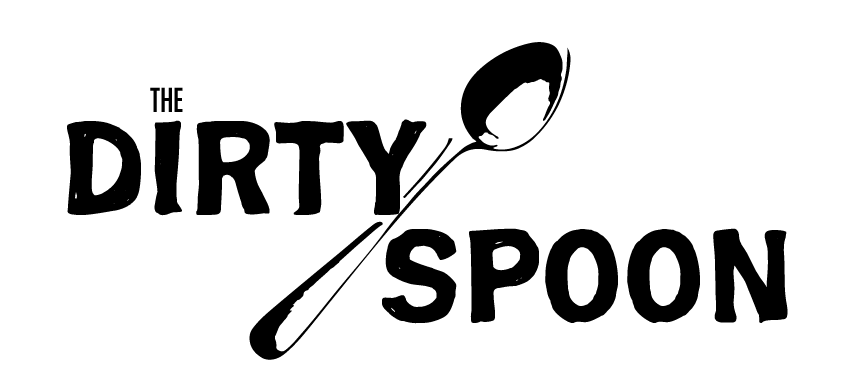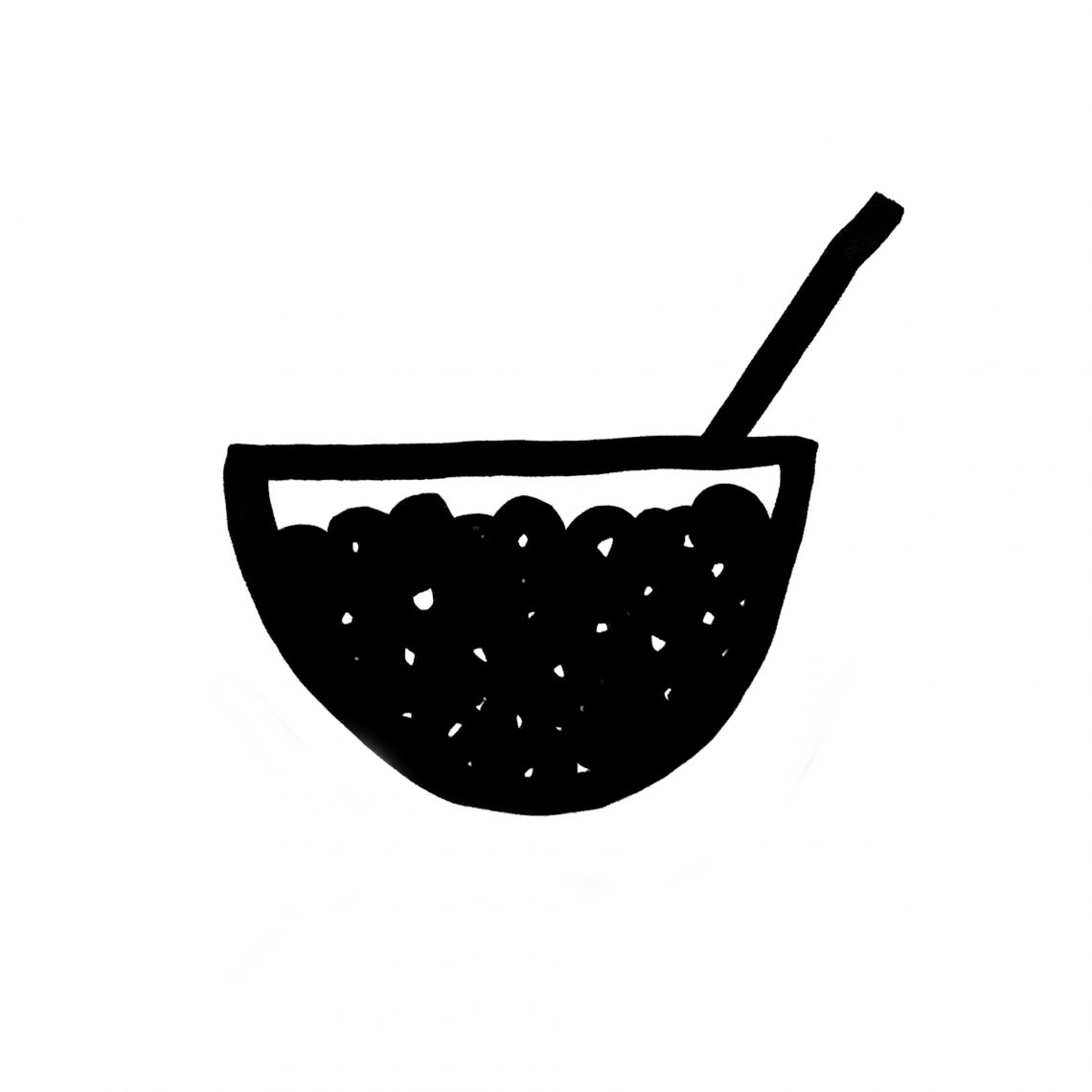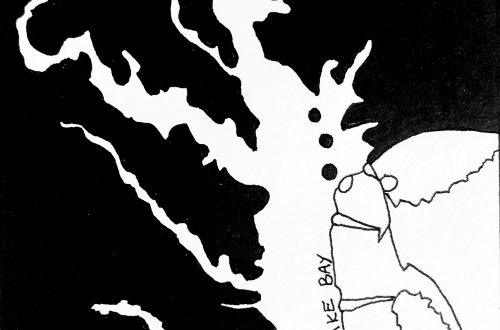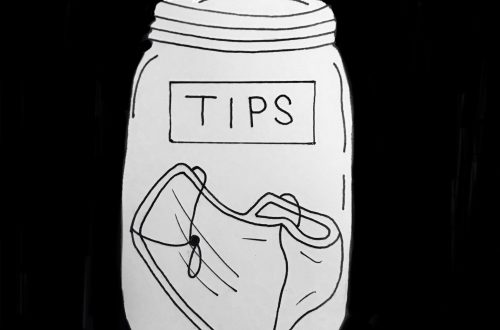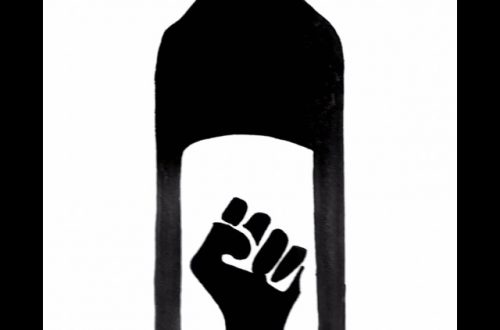by Kitta MacPherson
Art by Garnet Fisher
Kitta’s essay, “Cheerio,” appears in episode six of The Dirty Spoon Radio Hour, which aired on October 5, 2018.
I am an ocean. Simple things, fragile, weak items are my tides. Invisibly, they move me. A carnival of colors, shapes, objects, and savors stir me to my depths, and are portals to potent memories. In the tumult that is life, I know this: when I touch certain bowls and a particular spoon, when I encounter specific tastes, I am comforted and, for the moment, content.
Container
Most mornings, I start with a search for one of my golden, hand-painted terracotta bowls, stacked in a kitchen cabinet. I acquired them in 2012 at a shopping mall in Princeton, N.J., during a summer sale. I can recall the blinding brightness of the sun and how it matched a happy turn my life had taken. These sturdy bowls are mightier than they seem — they can hold a pint of black-bean chili, two cups of mulligatawny soup, or 16 ounces of milk-and-Cheerios. They beckon the hungry. Within their inner, concave surfaces they gleam a milk-chocolate brown. Bright bands of mustard-gold ring the outer shells. Yellow and black filigrees dance along the rim where you place your lips and gulp when no one’s watching. Most arresting are the bowls’ six, inch-high sunflowers, each clinging to the next. They dance in a ring, playing a children’s game. In my cabinets, there are many bowls. Only one of the four sunflower half-orbs will do for breakfast.
I once possessed six. Two have gone missing, the second a few months ago. Days after that disappearance, I found shards forming a sunburst in the kitchen garbage. The bowl remnants peeked from beneath a Twinings Earl Grey teabag and a mound of Ragu-stained rigatoni. No one confessed to the demolishment. I couldn’t bring myself to ask. The loss of that bowl hurt, sucking the sunshine out of me.
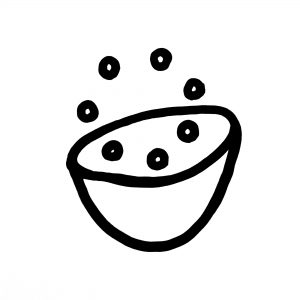
Tool
My every-morning eating utensil, my battered, sterling silver Mary Poppins spoon, is one with the character it conveys. The object cannot be separate from the idea. A miniature version of the heroine of both P.L. Travers’ book series and the 1964 Walt Disney movie forms the upper reaches of the spoon handle. It stands no more than an inch-and-a-half-high. An examination of the formed metal shows Mary to be in her movie work clothes. She balances a carpetbag in her left hand with the parrot-hook of an open umbrella in her right. The two-dimensional form, configured like a bas-relief, is jaunty, her flower-bedecked hat adding to the sauciness. If you clasp the spoon between thumb and forefinger, hold it high and swoop it into your cereal bowl, you can imagine Mary flying, all prim and businesslike. As if anyone can do it.
One sunny summer afternoon in the 1960s when I was a girl, I strode into my quiet kitchen in the center of my Dutch blue house in suburban Oyster Bay, Long Island, New York. I slid into a seat at a large, round wooden table, joining my maternal grandparents. My “Nana” and “Daddy Ed,” who lived with us, froze when they saw me enter the kitchen. They gleamed with delight. “Miss Kitta!” they exclaimed. It was as if they were out of air and I had appeared with oxygen masks. Their love was a thunderbolt. I scanned my simple little body, from my puffed sleeve shirt and tan overalls down to my white socks and sneakers. I thought I was sparkling. As we snacked on graham crackers and milk, they spoke. It was tea time and they were engaged in a daily ritual I had interrupted. My mother’s father was a jovial gentleman, a White Anglo-Saxon Protestant blueblood with provable lineage that dated back to the Revolutionary War and Scotland before that. He was a Yankee and an Anglophile. When he drank his tea, he would lift his cup, wink at me and say to my grandmother, “Pip, pip, cheerio, and all that!” My Irish Catholic Nana would feign annoyance and chide her husband of 50-plus years. “You know the English stole the word from us!” she would say. “The word, “Tioraidh,” is Gaelic.” She would clink her teacup with his, smile at me, and say, “Tioraidh!” I had to agree with Nana – as she pronounced it, the word sounded similar to the English word, “cheery.” I loved to watch how they loved each other.
My mother burst in then, excited. “Kitta, you have a package!”
I ripped through the brown wrapping and discovered its contents, giving me my first glimpse of my Mary Poppins spoon. I hugged my spoon. I hugged my mother. I danced. My grandparents clapped. “It took a lot of boxtops,” my mother added. “We ate a lot of Cheerios for that spoon.”
I brought the spoon with me when I moved away after college. Since, I have lived in five apartments and five homes. My spoon is no longer shiny. Like me, it’s worn. And, if you look at it in just the right way, it sparkles.
Sustenance
Cheerios are still produced by the puffing technique invented in 1941 by General Mills physicist Lester Borchardt. A Buffalo News reporter who toured the company’s Buffalo factory more recently observed that Cheerios are made by workers who take an oat flour base, mix it into a dough, toast it, then extrude it. Somewhere along the line the would-be Cheerios pop like popcorn, forming tiny, crunchy morsels shaped like inner tubes.
The interjection “cheerio,” according to the Merriam-Webster dictionary, is of British origin and is used as a greeting, toast, or farewell. Having a bright-as-a-buttercup box of Cheerios before you – I prefer the large, 18 oz. version – can induce idolatry. The box glows. A color gradient is used in its packaging design. The color surrounding the central heart-bowl image (replete with four strawberries forming eyes, a nose, and mouth) is a butter yellow and intensifies as it radiates outward. By the time the eyes reach the box edges, the surface has warmed up to butterscotch. The kitchen of my childhood was yellow. So was the kitchen in the home where I lived for 20 years with my husband and children. Yellow-gold allows me to feel the sun on my face. I hear bees buzzing.
I am back in the kitchen of my childhood. The yeasty smell of hot oatmeal fills the room. It’s the aroma of morning, the fragrance of home. Oatmeal was a staple in my family. Daddy Ed showed me how to eat it: sprinkling it with a teaspoon or two of sugar, covering the porridge with milk, and throwing on sliced bananas or strawberries. Delicious. I’m alone for a moment until my mother steps in. She scoops oatmeal out of a pot on the stove and plops it into a bowl. She sits me down with a spoon and napkin. She sets a small milk pitcher on the table and absently walks out. As my teeth crunch on the sugar crystals, I hear yelling. We MacPhersons rarely raise our voices. The resonance of the sound is unfamiliar and frightening to me. I peer out the kitchen door and up from my position on the main floor into the second-floor hallway of our split-level home. My mother and father are there. They stand close. They are arguing.
“If you want them here, then my father can live here, too,” Dad shouts.
Mom is crying. “John, your father is too sick,” she says. “I can’t take care of him.”
Nana and Daddy Ed climb upstairs from their room on a lower floor, off the den, joining me on the landing. Only they don’t see me. I am hugging the wall. They carry suitcases. My grandfather’s face is red. Nana looks down. I want to make it all stop.
“Daddy,” I scream. “No!” I am out of control, crying and shaking. I am on my knees begging my father. “Please, please, please!”
My father stares down at me from the far end of the corridor. I swallow and breathe out hope. But he exits into the master bedroom and closes the door.
Daddy Ed pulls out one of the starched white handkerchiefs he always keeps folded in his front pocket. He kneels down and dabs my tears. “There, there, Little Feller,” he said, using his nickname for me. Nana puts her hand on my shoulder and squeezes it gently.
Mom leads them outside where she drives them, I learn later, to an apartment in Rego Park, Queens, more than 30 minutes away. They will live there now.
Experience
I grab one of my brown-gold bowls and my dented but queenly silver spoon and pour in my Cheerios, and douse the donut-shaped bits with milk. I wait until the oat nuggets grow soggy, then I dig in. These oat toroids are mushy and slightly sweet, with a grainy flavor. It doesn’t matter where I eat them. I can lean over a counter, place the bowl on my desk, or sit properly at the kitchen table with the newspaper to my left. When I’ve reached the bottom of the bowl and there’s only a dab of milk left, I am strangely serene. Mornings are still golden. You never know when happiness will arrive. You can’t foresee when something will break. In my life, breakfast is my constant. The past is present, with its joy and sadness and lessons. I know I will be ever drawn to these objects. The love memory they evoke warms me for my day.

